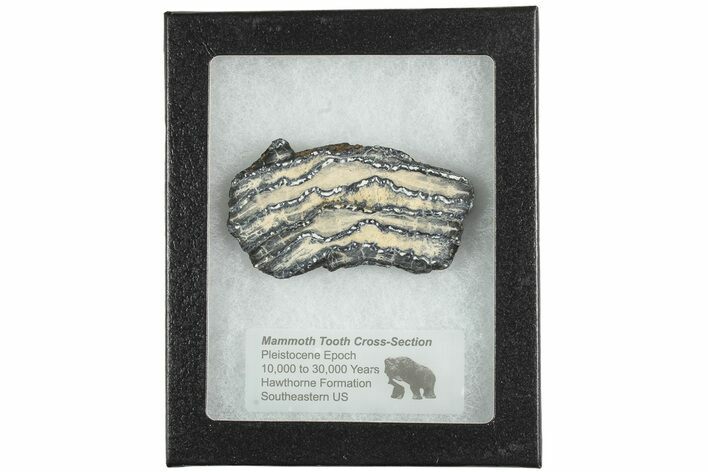This Specimen has been sold.
3" Mammoth Molar Slice with Case - South Carolina
This is an interesting cross-sectional slice of a Columbian mammoth (Mammuthus columbi) molar collected from a river in South Carolina. While complete mammoth molars in these rivers are rare, finding partial or fragmented molars is not uncommon. These partial mammoth molars are collected by divers who primarily look for Megalodon teeth on the river bottom. Many of these fragments are sliced just like this specimen, revealing unique new patterns within the enamel.
A Riker mount display case will accompany your purchase.
A Riker mount display case will accompany your purchase.
About the Columbian Mammoth
The Columbian mammoth (Mammuthus columbi) was one of the largest species of mammoths, towering up to 13 feet (4 meters) tall at the shoulder and weighing between 8 to 10 tons. These massive herbivores had long, curved tusks that could reach lengths of 10 to 16 feet (3 to 5 meters) and were primarily adapted to graze on grass, shrubs, and other vegetation.
Columbian mammoths roamed across North America during the Pleistocene epoch, approximately 1.5 million to 10,000 years ago. Their range extended from the southern parts of Canada through most of the United States and into northern Mexico. Unlike their woolly mammoth relatives, Columbian mammoths were better suited to temperate climates and open grasslands, favoring areas with abundant food sources.
Fossils of Columbian mammoths are commonly found in regions with ancient floodplains, riverbeds, or tar pits, such as those in the La Brea Tar Pits in California or various fossil-rich sites in Texas, Arizona, and Florida. These impressive creatures went extinct around 10,000 years ago, likely due to a combination of climate change and human activity.
The Columbian mammoth (Mammuthus columbi) was one of the largest species of mammoths, towering up to 13 feet (4 meters) tall at the shoulder and weighing between 8 to 10 tons. These massive herbivores had long, curved tusks that could reach lengths of 10 to 16 feet (3 to 5 meters) and were primarily adapted to graze on grass, shrubs, and other vegetation.
Columbian mammoths roamed across North America during the Pleistocene epoch, approximately 1.5 million to 10,000 years ago. Their range extended from the southern parts of Canada through most of the United States and into northern Mexico. Unlike their woolly mammoth relatives, Columbian mammoths were better suited to temperate climates and open grasslands, favoring areas with abundant food sources.
Fossils of Columbian mammoths are commonly found in regions with ancient floodplains, riverbeds, or tar pits, such as those in the La Brea Tar Pits in California or various fossil-rich sites in Texas, Arizona, and Florida. These impressive creatures went extinct around 10,000 years ago, likely due to a combination of climate change and human activity.
SPECIES
Mammuthus columbi
AGE
LOCATION
River in South Carolina
SIZE
3 x 1.7", up to .4" thick
CATEGORY
SUB CATEGORY
ITEM
#207576
We guarantee the authenticity of all of our specimens.
 Reviews
Reviews













